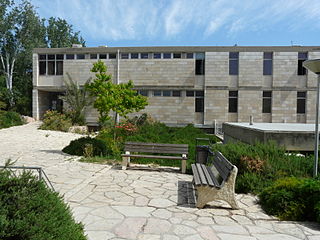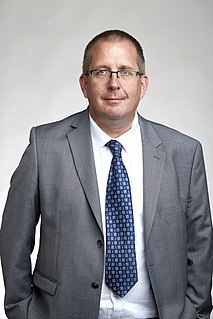
Zhores Ivanovich Alferov was a Soviet and Russian physicist and academic who contributed significantly to the creation of modern heterostructure physics and electronics. He was the inventor of the heterotransistor and shared the 2000 Nobel Prize in Physics. He also became a politician in his later life, serving in the lower house of the Russian parliament, the State Duma, as a member of the communist party since 1995.

Nick Holonyak Jr. is an American engineer and educator. He is noted particularly for his 1962 invention of a light-emitting diode (LED) that emitted visible red light instead of infrared light; Holonyak was then working at General Electric's research laboratory in Syracuse, New York. He is a John Bardeen Endowed Chair Emeritus in Electrical and Computer Engineering and Physics at the University of Illinois at Urbana-Champaign, where he has been since leaving General Electric in 1963.
Electron cyclotron resonance is a phenomenon observed in plasma physics, condensed matter physics, and accelerator physics. An electron in a static and uniform magnetic field will move in a circle due to the Lorentz force. The circular motion may be superimposed with a uniform axial motion, resulting in a helix, or with a uniform motion perpendicular to the field resulting in a cycloid. The angular frequency of this cyclotron motion for a given magnetic field strength B is given by

Indium phosphide (InP) is a binary semiconductor composed of indium and phosphorus. It has a face-centered cubic ("zincblende") crystal structure, identical to that of GaAs and most of the III-V semiconductors.

The International Union of Pure and Applied Physics is an international non-governmental organization whose mission is to assist in the worldwide development of physics, to foster international cooperation in physics, and to help in the application of physics toward solving problems of concern to humanity. It was established in 1922 and the first General Assembly was held in 1923 in Paris.

A Penning trap is a device for the storage of charged particles using a homogeneous axial magnetic field and an inhomogeneous quadrupole electric field. This kind of trap is particularly well suited to precision measurements of properties of ions and stable subatomic particles. Geonium atoms have been created and studied this way, to measure the electron magnetic moment. Recently these traps have been used in the physical realization of quantum computation and quantum information processing by trapping qubits. Penning traps are used in many laboratories worldwide, including CERN, to store antimatter like antiprotons.

A polaron is a quasiparticle used in condensed matter physics to understand the interactions between electrons and atoms in a solid material. The polaron concept was first proposed by Lev Landau in 1933 to describe an electron moving in a dielectric crystal where the atoms move from their equilibrium positions to effectively screen the charge of an electron, known as a phonon cloud. This lowers the electron mobility and increases the electron's effective mass.
Heinz-Jürgen Kluge, known as Jürgen Kluge, is a physicist probably best known for the development of ion-storage devices and methods for accurate measurements of nuclear masses.
An extrinsic semiconductor is one that has been doped; during manufacture of the semiconductor crystal a trace element or chemical called a doping agent has been incorporated chemically into the crystal, for the purpose of giving it different electrical properties than the pure semiconductor crystal, which is called an intrinsic semiconductor. In an extrinsic semiconductor it is these foreign dopant atoms in the crystal lattice that mainly provide the charge carriers which carry electric current through the crystal. The doping agents used are of two types, resulting in two types of extrinsic semiconductor. An electron donor dopant is an atom which, when incorporated in the crystal, releases a mobile conduction electron into the crystal lattice. An extrinsic semiconductor which has been doped with electron donor atoms is called an n-type semiconductor, because the majority of charge carriers in the crystal are negative electrons. An electron acceptor dopant is an atom which accepts an electron from the lattice, creating a vacancy where an electron should be called a hole which can move through the crystal like a positively charged particle. An extrinsic semiconductor which has been doped with electron acceptor atoms is called a p-type semiconductor, because the majority of charge carriers in the crystal are positive holes.
Donal Donat Conor Bradley, is the head of the Mathematical, Physical and Life Sciences Division of the University of Oxford. He is also a Professor of Engineering Science and Physics at Jesus College, Oxford. From 2006 to 2015, he was the Lee-Lucas Professor of Experimental Physics at Imperial College London. He was the founding director of the Centre for Plastic Electronics and served as vice-provost for research at the college.

The Racah Institute of Physics is an institute at the Hebrew University of Jerusalem, part of the faculty of Mathematics and Natural Sciences on the Edmund J. Safra Campus in the Givat Ram neighborhood of Jerusalem, Israel.
Ian A. Walmsley FRS is Provost of Imperial College London where he is also Chair of Experimental Physics. He was previously pro-vice-chancellor for research and Hooke Professor of Experimental Physics at the University of Oxford, and a professorial fellow at St Hugh's College, Oxford. He is also director of the NQIT hub within the UK National Quantum Technology Programme, which is led by the University of Oxford.
Morton B. Panish is an American physical chemist who, with Izuo Hayashi, developed a room-temperature continuous wave semiconductor laser in 1970. For this achievement he shared the Kyoto Prize in Advanced Technology in 2001.

Elias (Eli) Burstein was an American experimental condensed matter physicist whose active career in science spanned seven decades. He is known for his pioneering fundamental research in the optical physics of solids; for writing and editing hundreds of articles and other publications; for bringing together scientists from around the world in international meetings, conferences, and symposia; and for training and mentoring dozens of younger physicists.
Kenneth John Button was a solid-state and plasma physicist. He was the editor-in-chief of the International Journal of Infrared and Millimeter Waves from its inception in 1980 until his resignation in 2004.

Octiabr' V. Emelianenko was a Soviet physicist, Ph.D. in Physics and Mathematical Sciences. He did fundamental work in physics of III-V compound semiconductors, and made significant contributions to pave the way for the creation of the first semiconductor laser, optoelectronics, LEDs, solar cells, infrared detectors and other semiconductor devices.
Brian Kidd Ridley is a British solid-state physicist specialising in semiconductor theory. He is an emeritus professor at the University of Essex.

Guy Roderick Wilkinson is a particle physicist, working on the Large Hadron Collider project at CERN, professor of physics at the University of Oxford and a Fellow of Christ Church.

















